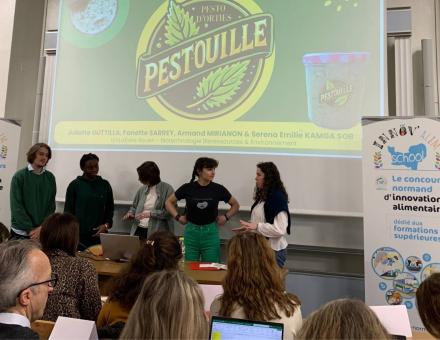Check out the new article by Messika Revel, Teacher-Researcher in Ecotoxicology, for The Conversation.
Adults are estimated to ingest about 50,000 plastic particles per year, and babies more than one million per year. Plastic particles can be ingested through drinking or tap water, contaminated food (in direct contact with plastic packaging), through ambient air containing microfibers (from textiles, for example) or through skin contact with hygiene products.
The toxic effects of these particles on humans are still unknown but there are three main health risks: the diffusion of toxic chemical components such as additives (bisphenols, phthalates, metals); the release of harmful substances adsorbed by particles, which then act as vectors of environmental pollutants; and physical damage directly caused by plastic debris (fragments, fibers, foam, microbeads) causing lesions or obstruction in various organs. Several studies have highlighted effects at the cellular level, in particular increased inflammation, oxidative stress, cell death and disruption of energy metabolism.
The aquatic environment is the final receptacle of waste and contaminants related to these "microplastics" (smaller than 5 millimeters) and is therefore particularly studied. At the beginning of September 2021, the number of plastic fragments floating on the surface of the oceans was estimated at 24,400 billion, with an estimated weight of between 82,000 and 578,000 tons.
For several years, more and more laboratories have been studying the toxic effects of plastic particles in marine and freshwater organisms, including bacteria, fish and aquatic plants, but the wide variety of characteristics of these particles, such as their size, shape, type of polymer (polyethylene, polypropylene, polystyrene, etc.) and added additives, make the effects difficult to disentangle. While the toxicity of these particles can be assessed individually in each of these species, it will take a considerable amount of time to test all existing particle types and associated additives.
Among the complementary or even alternative methods, cell culture, also known as in vitro testing, could be a promising tool to assess the toxicity of different plastic particles. This approach presents technical challenges and also limitations, notably to extrapolate the results to whole organisms... like humans.
The interest of cell culture to evaluate the toxicity of micro and nanoplastics
Scientists, who are used to working with animal models, are facing more and more ethical, economic and environmental challenges in their practices.
Cell culture is mainly used to evaluate toxicity at the level of cells from certain organs, for example the liver or the lungs, and the mechanisms involved, in a wide variety of experimental conditions.
Currently, in vitro studies are being developed to determine the toxicity of contaminants in several aquatic organisms. This tool would have a strong ethical interest because it would allow to respect the "3Rs principle": replace the use of animals by other experimental methods, reduce the number of animals used in experiments, and improve experimental procedures in order to reduce animal suffering.
In vitro testing also allows for rapid screening of potential chemical toxicity prior to further analysis with in vivo testing, and correlations between in vivo and in vitro testing confirm that cell cultures could be an alternative method to animal testing.
The second advantage of cell culture is that it allows the evaluation of many biological impacts, such as DNA damage or cell viability under different conditions, because the size scale of the tests is much smaller than exposing animals in aquaria - which also reduces costs.
Finally, it allows the study of cellular mechanisms involved in toxicity, such as the production of reactive oxygen species linked to the increase in oxidative stress, which can induce lipid peroxidation and damage the membranes of cellular organelles, potentially leading to cell death.
Thus, research has shown that all types of plastic particles have potentially harmful effects on cells with cytotoxicity, immunotoxicity and increased oxidative stress.
The difficulties of cell culture for ecotoxicological assessment
The first difficulty is the limited number of standardized cell lines available for aquatic organisms. Apart from commercialized lines for fish models, for other aquatic species, it is necessary to isolate cells and culture them in the laboratory before performing the tests. This requires a significant period of development, the accuracy of which must be firmly established before any toxicity test can be performed. The origin of the cells is considered a limitation since cells from some organs are more difficult to maintain than others and require specific culture media.
The composition of the culture medium also seems to play a role in the response of the cells to the microplastics, since the presence of certain compounds could induce changes in the physicochemical properties of the plastic nanoparticles and thus their interaction with the cells.
Limitations of this approach
Despite its potential, the use of cell culture to study the toxicity of microplastics and nanoplastics is still in its infancy with a number of limitations.
For microparticles, an alternative approach using tissue or organ cultures seems to be more suitable as large particles will tend, in vivo, not to penetrate cells and interact with organs and tissues.
On the other hand, the use of cell cultures has a limitation in that it does not accurately reproduce the conditions of cells in a whole organism. For example, isolated and cultured cells typically differ greatly from the corresponding cell type in an organism, limiting the value of in vitro data for predicting in vivo toxic impact.
Much work continues to be done to optimize cell culture assays, including the use of culture media under conditions more similar to those encountered in vivo, such as in three dimensions.
Messika Revel, Associate professor in ecotoxicology, UniLaSalle
This article is republished from The Conversation under a Creative Commons license. Read the original article.






